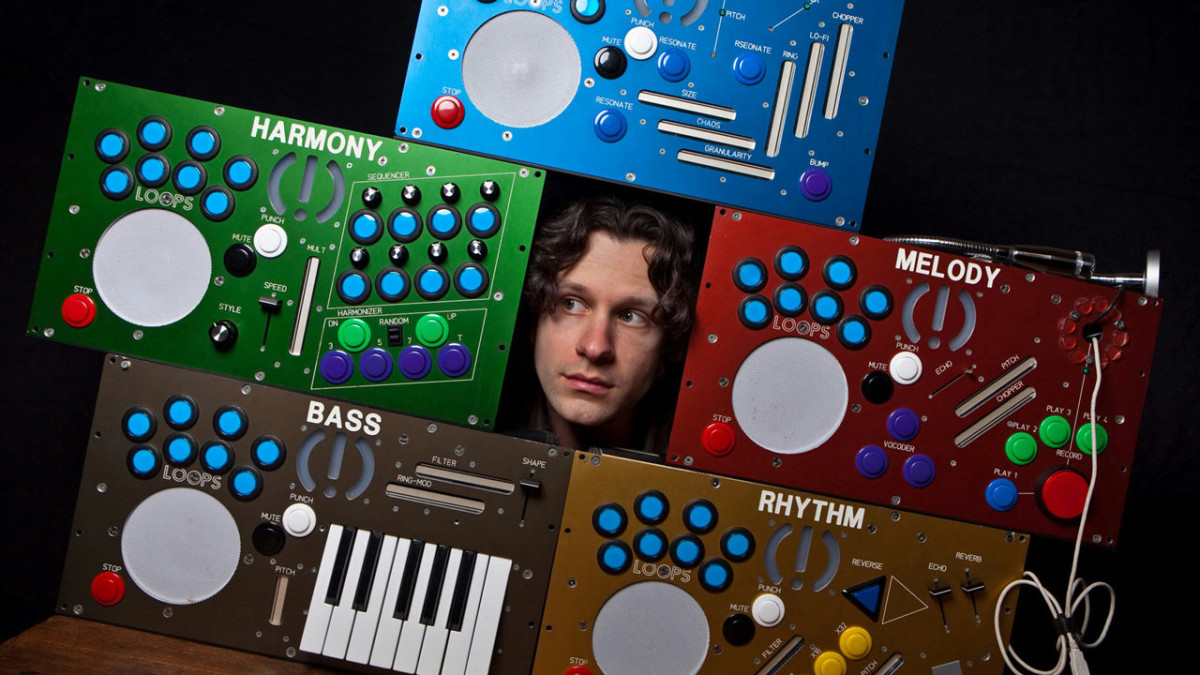
Moldover's Marvelous Machines
My early background is in traditional musicianship, but I’ve been performing electronic music and designing new instruments for almost 20 years now. I love bridging the visceral joy of live music making with the technical puzzles I uncover when inventing new ways to make sound. Combining these very dissimilar disciplines gives balance to my art and brings a distinct character to my creations. The two interactive experiences I’ve designed for the Museum of Making Music present different opportunities for guests to try their hand at music making with new technology.
“The Collaborator” is a multiplayer electronic instrument, or what my colleagues simply call a “jambox.” Four different musical devices sit atop a table, each covered with a unique assortment of buttons, pads, proximity detectors, and other sensors. Each device controls one instrument in a quartet consisting of drums, bass, melody, and atmospherics. I’ve applied my favorite interaction and sound design techniques to make each device intuitive enough to jam with immediately, but also nuanced and expressive enough to allow for deeper exploration. The real magic is how the four devices are programmed to help participants play in sync and in key with each other, making musical collaboration instantly accessible to non-musicians.
“The Live Mixing Experience” offers a playful simulation of what it’s like to be both a live sound engineer and a lighting technician at the same time. Guests approach a podium holding a simplified sound-mixer which is surrounded by an array of stage lights. The lights are carefully focused on different parts of a mural that shows the silhouettes of an imaginary “everyband” on stage. Touching the mixer starts the playback of a multitrack piece of music. By moving faders to balance the volume of different instruments and turning knobs to experiment with audio effects, guests have complete control of a live sound mix. Furthermore, the stage lighting reacts to the sound of each instrument, illuminating the drummer in the mural with each bass drum and snare hit, the keyboardist with every chord, and so on. Audio and lighting effects are controlled in tandem from the same physical controls, with a separate section of the mixer dedicated to movable spotlights and other dynamic lighting. The end result is a unique, hands-on, synesthetic playground for music and light.
I’m passionate about building experiences like these that lower barriers to exposure, providing people from any background with a hands-on taste of these uncommon crafts. If we can help someone discover how exciting it is to improvise and collaborate with electronic instruments or share how captivating it can be to assume the offstage role of an expert in light or sound, perhaps we can inspire them to pursue creative and technical fields they might not otherwise have considered. Additionally, watching the instant delight that these novel interactions bring to museum guests returns that delight to me as a designer.
The remarkably talented and industrious team at the Museum of Making Music deserves as much credit for the realization of these projects as I do. From ideation to custom-built hardware, visual presentation elements, and much more, these works are definitively team initiatives. I am deeply grateful for these opportunities to share my enthusiasm for playful tech experiences with this supportive institution, their patrons, and their guests.

